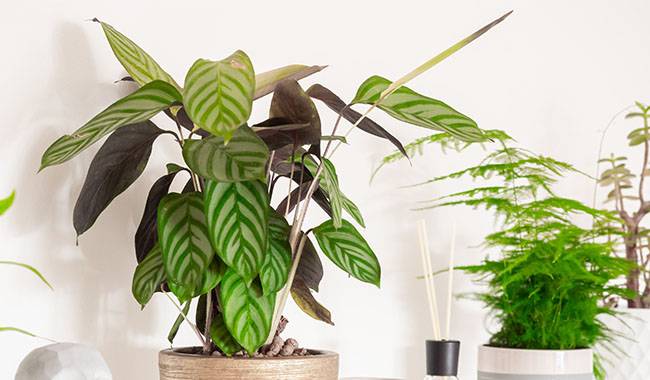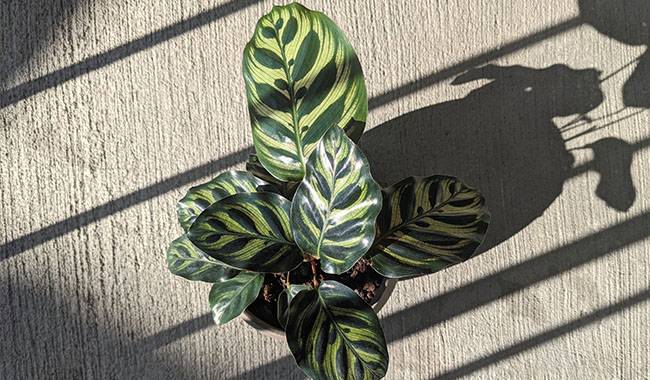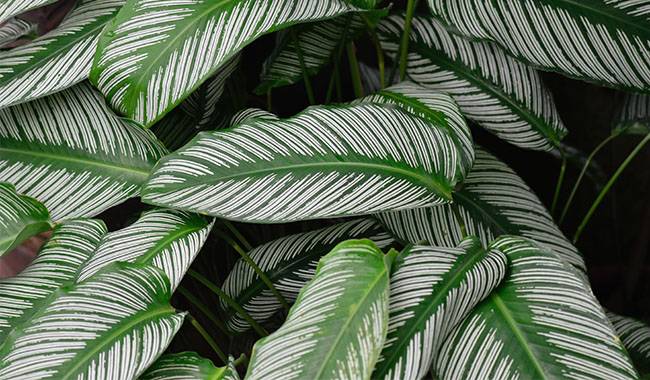
Many florists believe that the guardian plants of the family home should be thanked for bringing peace and tranquility to the home. This includes Calathea, often referred to as the “flower of prayer.” A well-tended plant looks very beautiful, but even Calathea sometimes needs help. How to maintain the unusual beauty of the plant and how to organize the conditions for its successful cultivation, I have learned about caring for striped Calathea. In this article from Thumbgarden, I will be happy to share some of my secrets. You will learn How to Care for and Grow Calathea Plant in the ThumbGarden article.
WHAT DOES CALATHEA LOOK LIKE?
Calathea is valued for its unusual color and leaf stripes. The stripes on the leaves, forming a geometric pattern, perfectly match the Latin name “zebrina”. It produces small, non-expressive flowers with no ornamental value. Calathea is grown for its splendid large leaves and unusual color.
Each vein seems to have been painted with the brush of an unknown artist, and the contrast of shades in a single color is so striking that it creates an extra sense of volume in the leaves. The underside is mostly a soft mauve color.
Calathea is an herbaceous plant that grows to 30-32 inches (75-80 cm) in nature. However, in indoor conditions, the height limit will be about 23 inches (60 cm).
GROWING CONDITIONS FOR CALATHEA PLANTS

Some flower growers consider Calathea to be capricious. This may be true for other species as well. But I have not had any particular difficulty in caring for my striped Calathea. It is enough to remember that it is native to the tropics and therefore requires high humidity, temperature control, and prevention of pests and diseases that will actively multiply under favorable conditions.
Calathea Plant is the most commonly grown indoor plant. It is easy to tell from the appearance of this Calathea whether it is being properly cared for or whether it is feeling uncomfortable. The first signs of poor care are loss of bright contrast and curling of the edges of the leaves.
Sunlight
In the wild, Calathea lives in tropical rainforests. The plant’s height is relatively low, so it gets very little sunlight. It welcomes every ray of light that breaks through the dense canopy of the forest giant.
In the course of its evolution, Calathea developed the interesting feature of not only turning like a sunflower after a light source but also of lifting its leaves in the evening and folding them into a small cup. In the morning, they are lowered and the leaf plates are ready to welcome the sun’s rays again.
Because of these characteristics, striped Calathea, like other species, is very sensitive to light levels. It should not be planted on an unshaded windowsill in the south. However, Calathea is an original decoration in a room.
It will live well on a northern windowsill, just be sure to keep the foliage out of direct sunlight and shade the windows.
Temperature pattern
Calathea’s temperature limit is 59 °F (15°C). As the heat increases, the humidity increases proportionally. It is not recommended to raise the temperature above 77 °F (25°C). Eustoma striata are uncomfortable in high temperatures, and high temperatures reduce the plant’s resistance to diseases and pests.
Incidentally, the plant is very afraid of sudden changes in temperature and airflow and will react quickly by changing its color and the hardness of its leaves.
HOW TO CARE FOR CALATHEA PLANTS AT HOME

Watering and humidifying the air
The main reason for the loss of decorativeness and turning into a tortured bush (even if the conditions are ideal) is the lack of water. calathea needs a lot of water, that’s all.
- The water should be soft; if it is too hard, you can put sticks or a handful of peat into the container.
- During the peak growth period, water heavily and be sure to empty the tray to avoid root rot.
- In winter, Calathea will lower its metabolic rate and enter a relatively dormant state; just keep the substrate slightly moist to reduce humidity.
To keep the humidity level high, I spray the leaves of Calathea with a sprayer every day. At home, it is usually placed on a tray with pebbles or moss and moistened regularly. I prefer to use moss because it absorbs moisture like a sponge and gradually gives it off.
Fertilization of Calathea
I choose a Calathea fertilizer designed for ornamental plants. Since the plant is not ornamental, the focus is on aggressive growth and the formation of green blocks.
I prefer to feed with trace mineral remedies at a rate of 1 teaspoon per 0.52 gal (2 liters) of water. The dosage for masters is the same. Apply fertilizer every 10-14 days in spring and summer. The remaining solution must be discarded, as the expiration date of the already diluted product is 1 to 3 days.
Transplanting Calathea
Young Calathea has a dense root system and therefore requires a larger pot every year. Mature specimens grow calmly in the substrate for 2-3 years at a time. Nutrient support is provided through fertilization.
Spring is the best season for transplanting. I use ready-made Calathea potting soil with at least 1 inches (2.5 cm) of drainage.
Calathea plants in dormancy
The intensive growth period of Calathea lasts from March to the end of September. This is followed by a period of relative rest when the plant is in a quiescent state. This lasts until about January. Growth does not stop completely, but it slows down to a minimum.
There is no need to remove Calathea from its usual place, just reduce watering and fertilize no more than once a month.
Note: Do not place Calathea plants near heaters!
Propagation of Calathea plants
I have not tried to propagate and grow Calathea from seed, but I have been told that it is a long and time-consuming process. The florist advised me to simply divide the mature specimens when repotting.
Prepare a new potting soil, a sharp knife, and wood ash. When splitting, Calathea roots often become intertwined. Cut them with the knife, cover them with wood ash, and plant in a 2:1 mixture of peat and sand.
Place a mini-greenhouse on top to retain moisture and water when the topsoil becomes dry.
MAIN CAUSES OF WILTING AND DEFORMATION OF CALATHEA LEAVES
The colorful leaves are the treasure of Calathea. In some cases, they lose their ornamental value.
- If the air is too dry, the flakes will lose their brightness, become translucent, and start to curl away from the edges. Spray more frequently and check the position of Calatea, which may be too close to the radiator.
- Round, dark or yellow spots may indicate sunlight hitting the droplets after spraying. You will need to change the sprayer to a smaller one and shade the window more carefully.
- Calathea also indicates a lack of moisture in the air if the leaves curl up into a tube and dry out. You can try to build a temporary frame greenhouse and place the plant there.
- If you find a sticky liquid tree body under the leaves when you check again, check the room temperature. This is usually Calathea’s response to heat.
- A yellowed, soft leaf on the underside is a wake-up call. This is the plant’s response to rotting roots. After removing the damaged part, replant the Calathea as soon as possible, dry it slightly, treat it with carnation, and adjust the watering schedule after replanting.
Another cause of loss of beauty is the presence of pests. Aphids, spider mites, thrips, scab mites, and sooty fungus can colonize the leaves and stems.
The most effective way to mechanically remove pests is to use a cloth soaked in a soap solution or nettle tincture at a ratio of 1 tablespoon of dry ingredients per 1 cup of boiling water. Infuse for 2-3 hours and allow to stand for 24 hours. If the infestation is severe, treat it with pesticides. the treatment can be repeated after 10 days to prevent new infestations.







